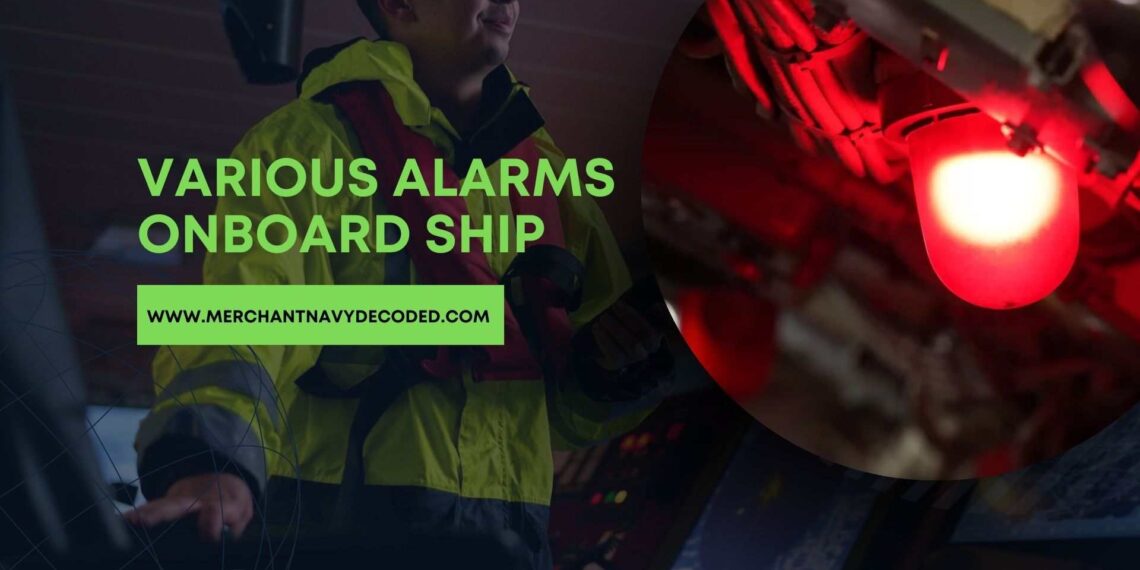Types of Alarms on Ships Every Seafarer Should Know
1:- What is an Alarm?
- An alarm is a device or system that notifies people about a specific issue or condition that has to be addressed immediately.
- Alarms can be audible (sound) and visual (lights) and are used in various settings, such as homes, businesses, vehicles, and ships, to warn of potential dangers or emergencies.
- Alarms help ensure that the crew can respond quickly to prevent accidents, protect the vessel, and ensure the safety of everyone on board.
2:- Why Alarms are Important on Ships?
Alarms are essential onboard ships since they are a necessary component of the vessel’s safety and operational systems. Here’s why alerts are important:
- Safety of Crew and Ship: Alarms warn the crew of potentially hazardous conditions such as fire, floods, or gas leaks. These early alerts allow for quick action to avoid mishaps, injuries, or even the loss of the ship.
- Prevention of Equipment Damage: Alarms alert the crew of failures or abnormalities in the ship’s machinery, such as engine overheating, low oil pressure, or electrical issues. This enables safety, avoiding equipment failure and costly repairs.
- Compliance with Regulations: International maritime regulations, such as those from the International Maritime Organization (IMO), require ships to have alarms in place to ensure safety at sea.
- Efficient Ship Operation: Alarms help the ship’s efficient operation by alerting the crew to difficulties that may impact navigation, propulsion, or other important systems.
- Environmental Protection: Alarms can detect leaks or other environmental hazards, allowing the crew to take action to prevent pollution of the marine environment.
If you’re a BTech Marine Engineering student looking to excel in your studies, don’t miss out on the BTech Excellence Package! Click here to get started and take your knowledge to the next level.
3:- Types of Alarms on Ships
Alarms on board ships are more than just basic alerts; they are complex systems that can manage a variety of emergencies. The following is a thorough list of the many alarms found on ships, complete with full information about each one.
3.1:- General Alarm on Ship
- The general alarm is potentially the most important alert system aboard a ship.
- This alert, identified by seven short rings of the bell followed by one long ring, or a similar sequence utilising the ship’s horn, indicates that an emergency has occurred.
- Fires, crashes, and scenarios that might lead to the ship being abandoned are examples of common conditions that cause the general alarm to sound.
Action Required in Case of a General Alarm on Ship:
- Proceed to the designated muster stations.
- Listen to the Public Address (PA) system for further instructions.
- Follow the muster list and regroup as per the assigned squad to tackle the situation.
3.2:- Fire Alarm on Ship
- Fire is one of the most dangerous emergencies on a ship. The fire alarm is activated either manually by pressing the nearest fire switch or automatically when the ship’s fire detection system senses smoke or fire.
- The alarm is a continuous ringing of the ship’s bell or horn.
Action Required in Case of Fire Alarm on Ship:
- Immediately proceed to the fire station.
- Confirm the location of the fire.
- Perform duties as listed in the muster list according to the assigned team.
3.3:- Man Overboard (MOB) Alarm on Ship
- The man overboard alarm sounds when a crew member or passenger goes overboard. The alert consists of three lengthy rings on the internal bell and three long blasts from the ship’s whistle.
- It is crucial to ensure a quick response to rescue the person in the water.
Action Required in case of an MOB Alarm:
- Identify the person overboard and the last known position.
- Launch a rescue operation as per the ship’s MOB procedures.
- Notify nearby vessels using the ship’s whistle and other signaling devices.
3.4:- Abandon Ship Alarm
- When the situation on board becomes uncontrollable, and the ship is deemed unsafe, the abandon ship alarm is sounded.
- This alarm is similar to the general alarm but is followed by verbal orders from the master or chief officer.
Action Required in Case of an Abandon Ship Alarm:
- Gather your lifejacket or immersion suit and proceed to the muster station.
- Take additional survival items as listed in the muster plan.
- Wait for the final order from the master to abandon the ship.
3.5:- Navigational Alarm on Ship
- The navigational alarm is linked to various equipment on the bridge, including navigational lights and radar systems.
- If any equipment fails or malfunctions, this alarm alerts the crew.
Action Required in Case of a Navigational Alarm:
- Identify the affected equipment.
- Attempt to rectify the issue or switch to standby equipment if necessary.
3.6:- Machinery Space Alarm
- This alarm is vital for the engine room, where various machinery is monitored continuously.
- If any machinery malfunctions, the alarm is triggered, indicating the problem on the control room panel.
Action Required:
- Determine which machinery or system is malfunctioning.
- Address the fault or switch to standby machinery if required.
3.7:- Machinery Space CO2 Alarm
- The machinery space is equipped with a CO2 firefighting system. This alarm is distinct from other alarms to ensure quick recognition.
- It activates when the CO2 release cabinet is opened.
Action Required:
- Prepare for the operation of the CO2 system, ensuring all personnel are evacuated from the affected space.
- Follow procedures for CO2 system deployment.
3.8:- Cargo Space CO2 Alarm
- Similar to the machinery space CO2 alarm, this system is installed in cargo holds.
- It ensures that the cargo space is sealed and free of crew before CO2 is released.
Action Required:
- Conduct a headcount to ensure no crew is inside the cargo hold.
- Confirm that all ventilation systems are shut before deploying CO2.
3.9:- Ship Security Alarm System (SSAS)
- In terms of SOLAS Chapter XI, the SSAS is a silent alarm that activates in the event of a security danger, such as a pirate attack.
- It makes no sound on the ship but warns coastal authorities via satellite communication.
Action Required:
- Follow security protocols as outlined in the ship’s security plan.
- Maintain communication with relevant authorities until the threat is neutralized.
4:- Conclusion
Understanding the various types of alarms on a ship is important for all seafarers. These warnings are more than just signals; they are life-saving systems that require an immediate and proper reaction.
Each alarm has a unique purpose, such as alerting the crew of a fire, a man overboard, or an electrical issue. Proper training and frequent drills make sure the crew responds quickly and efficiently, reducing dangers and saving lives at sea.
Seafarers who are familiar with these alerts and their accompanying standards can greatly contribute to the vessel’s safety and security.
5:- Alarms on Ships Frequently Asked Questions
The general alarm warns the crew of any emergency, such as a fire, collision, or the need to evacuate the ship. It consists of seven short rings followed by one long ring, or the same pattern as the ship’s horns.
The fire alarm system is activated manually or automatically when smoke or fire is detected. It triggers a continuous ringing or horn blast to alert the crew to the fire’s location, prompting immediate firefighting actions.
When the MOB alert sounds, the crew should quickly identify the person overboard, start rescue measures, and notify close vessels using the ship’s whistle and signaling systems.
The machinery space alarm warns the crew to any problems with the engine room’s machinery. In contrast, the CO2 alert signals the activation of the CO2 firefighting system, necessitating evacuation of the affected area prior to deployment.
The SSAS is a silent alarm that does not sound on the ship but notifies coastal authorities via satellite communication during a security threat, such as a pirate attack.
Check out more such amazing topics about Ships and Oceans.
Disclaimer :- The opinions expressed in this article belong solely to the author and may not necessarily reflect those of Merchant Navy Decoded. We cannot guarantee the accuracy of the information provided and disclaim any responsibility for it. Data and visuals used are sourced from publicly available information and may not be authenticated by any regulatory body. Reviews and comments appearing on our blogs represent the opinions of individuals and do not necessarily reflect the views of Merchant Navy Decoded. We are not responsible for any loss or damage resulting from reliance on these reviews or comments.
Reproduction, copying, sharing, or use of the article or images in any form is strictly prohibited without prior permission from both the author and Merchant Navy Decoded.





